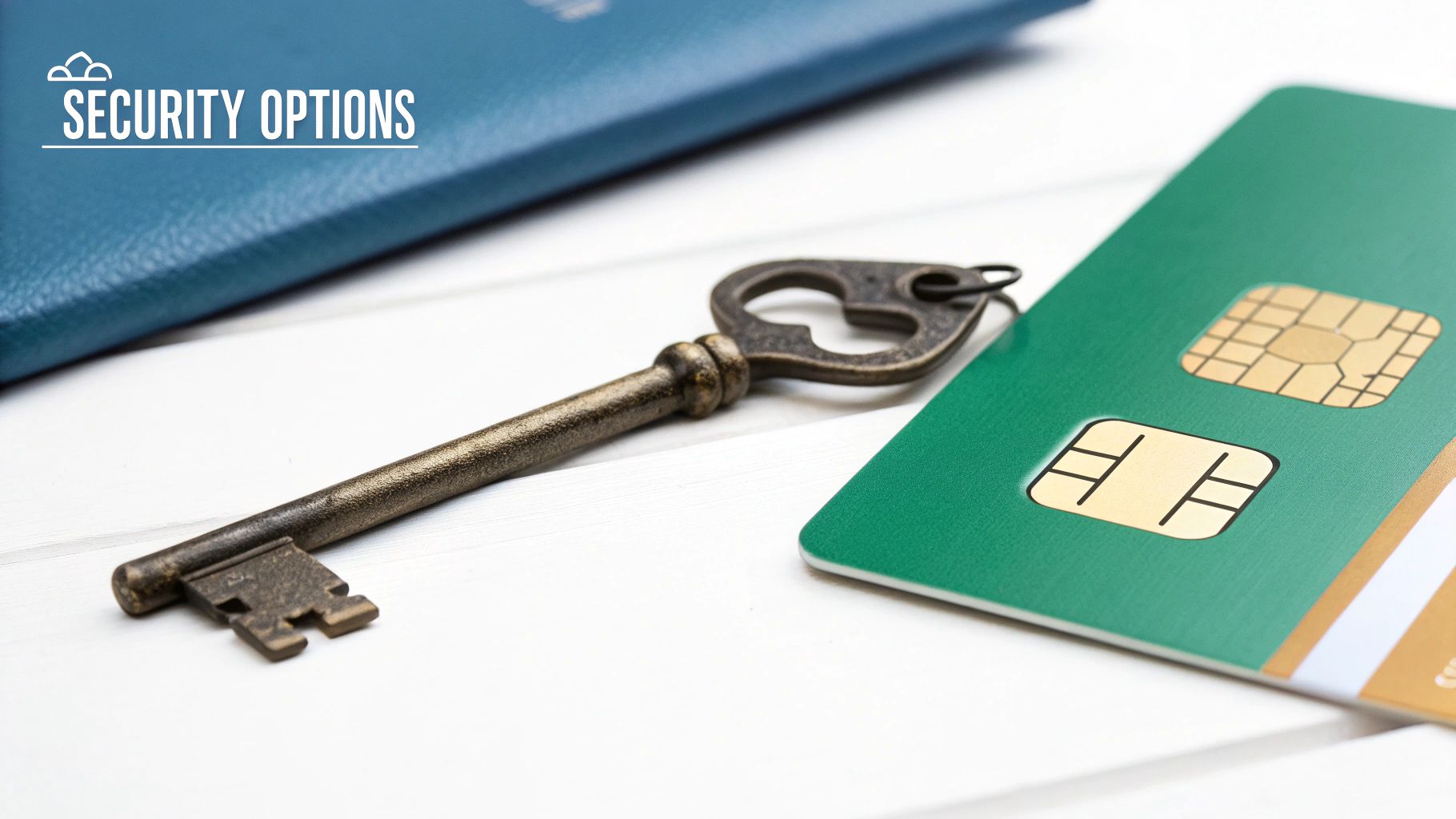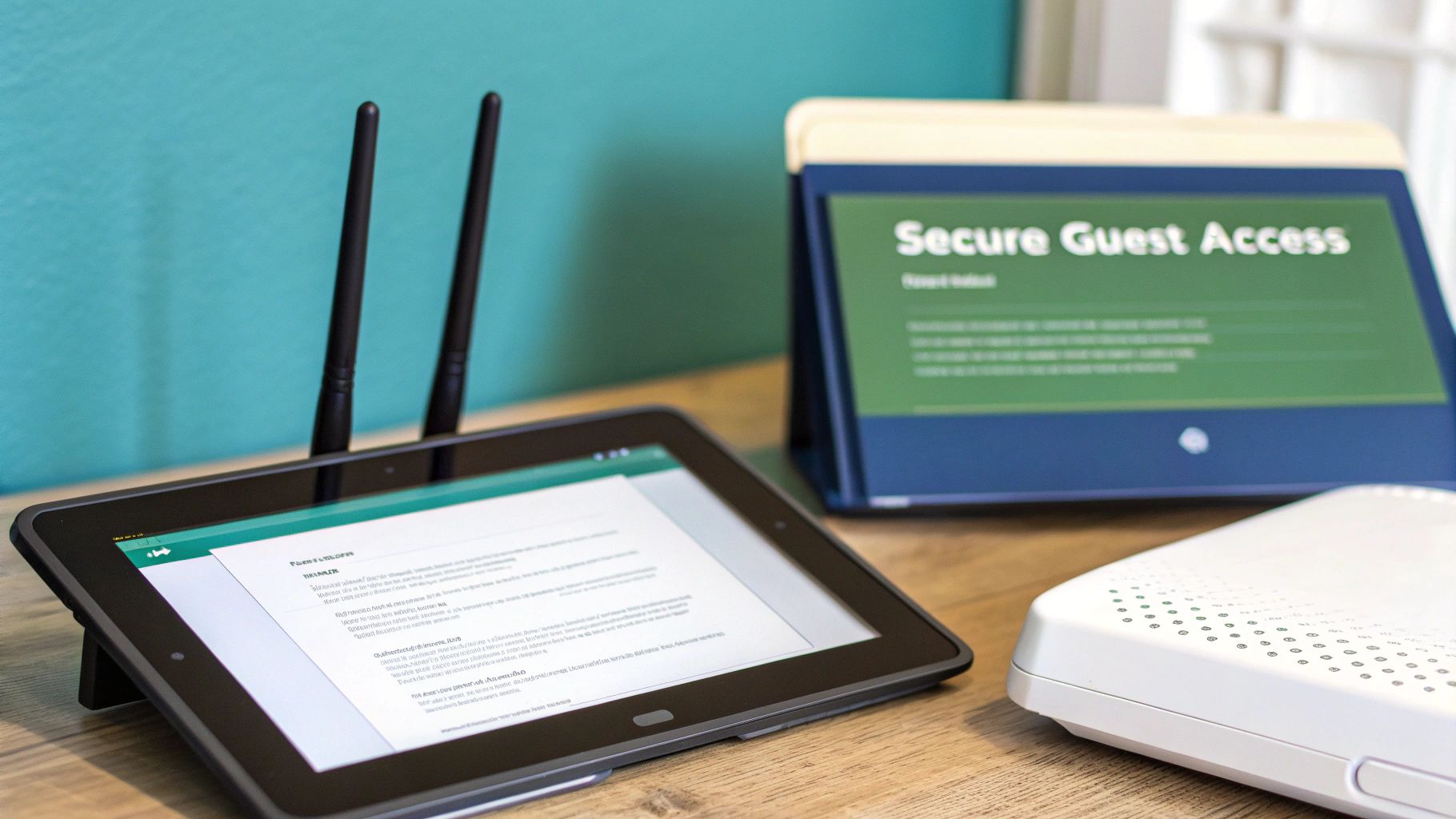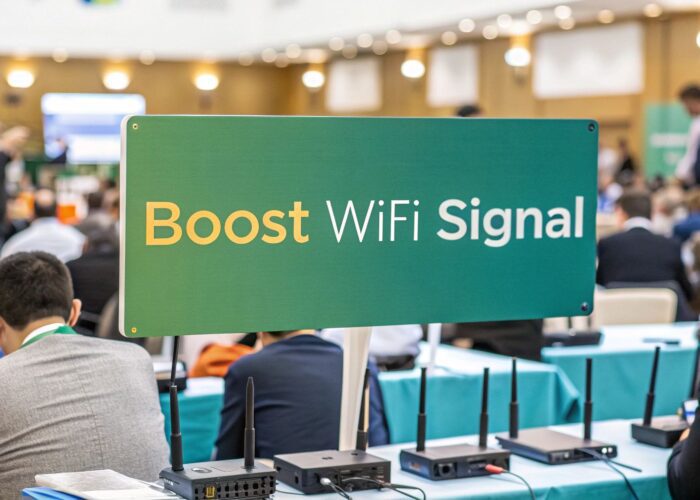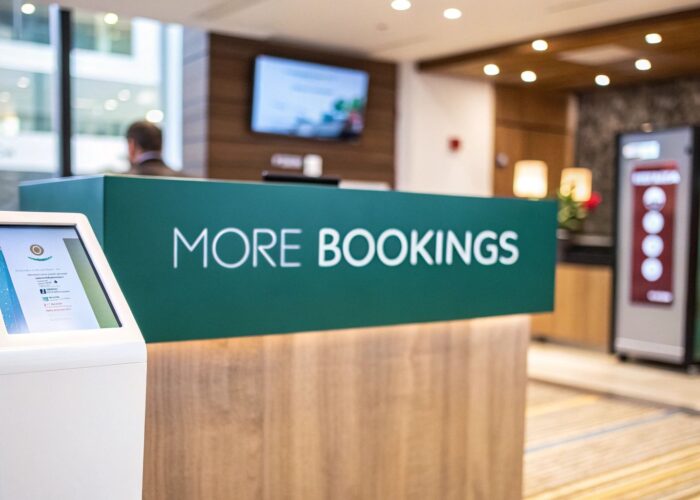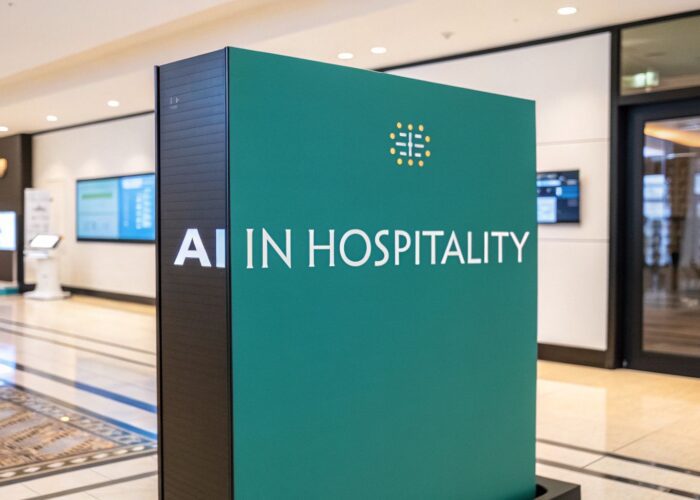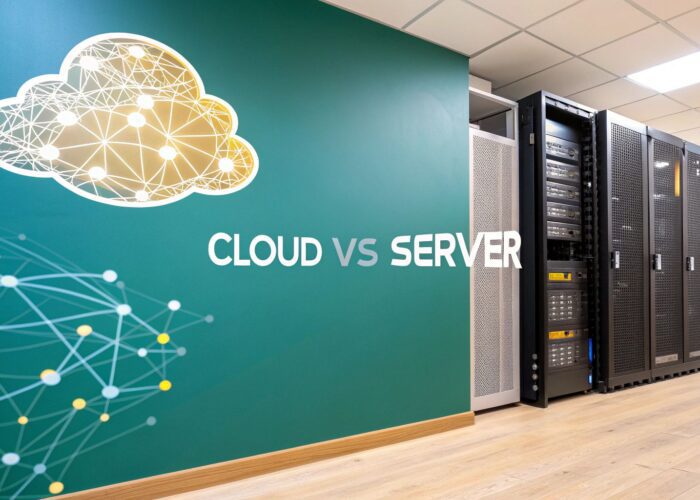Ever connected to a Wi-Fi network with a password? Then you've already met WPA2 with AES, the digital bodyguard that keeps your wireless world safe. Think of it as the super-strong, super-secret combination lock on your Wi-Fi's front door, protecting everything from your personal photos to sensitive company data. It’s the trusted standard for millions of devices worldwide, and getting it right is key to a secure network.
The Bedrock of Modern Wi-Fi Security
Let's be honest, most of us have connected to a password-protected Wi-Fi network without a second thought. That seamless, secure connection is all thanks to WPA2 with AES. This powerful duo has been the backbone of wireless security for over a decade, and for very good reason. So, what’s it actually doing behind the scenes?
Imagine your Wi-Fi signal is like sending a postcard. Without any protection, anyone who gets their hands on it can read your message. WPA2 with AES is like putting that message into a locked metal briefcase, using a code so complex that only the intended recipient can ever hope to open it. It keeps your digital chats private and ensures no one messes with them along the way.
Why It Became the Gold Standard
This protocol wasn't just a happy accident; it was a huge leap forward in security. Rolled out in 2004, WPA2 replaced its weaker predecessors by making the Advanced Encryption Standard (AES) a mandatory part of its security framework.
This was a massive deal. By adopting AES, WPA2 brought in powerful 128-bit encryption, which was a game-changer for data privacy and integrity. This move single-handedly raised the bar for what we all consider "secure" Wi-Fi.
This level of security is absolutely essential in places that manage lots of different users and their devices, such as:
- Education: Protecting student data and keeping campus-wide access secure is a top priority.
- Retail: Securing point-of-sale terminals and guest Wi-Fi networks is non-negotiable.
- Corporate BYOD: Safely managing a "Bring Your Own Device" policy without putting the internal network at risk.
For these environments, just deploying top-tier hardware like Cisco Meraki isn't enough. You have to know how to configure WPA2 with AES correctly. This is especially true when you move beyond a simple shared password and into modern Authentication Solutions like Captive Portals or Identity Pre-Shared Keys (IPSK).
We dig into the basics of the pre-shared key method in our guide on what WPA2-PSK is. And as our homes get smarter, this kind of robust security becomes just as important for our personal networks, especially with the rise of IoT home automation gateways.
How WPA2 and AES Work Together to Build a Digital Fortress
So, what’s actually happening under the hood when you connect to a secure Wi-Fi network? It helps to think of WPA2 and AES as two different specialists working together on the same security team. WPA2 is the master security protocol—it's like the vigilant guard at the gate who verifies credentials and manages access. AES, on the other hand, is the encryption cipher, the unbreakable secret code used to scramble all the data passing through.
Let's try another analogy: a secure bank transfer. WPA2 acts as the bank's entire security framework. It’s the process that confirms your identity, ensures all the rules are followed, and oversees the transaction from start to finish. AES is the specific technology that takes the account numbers and transaction details and turns them into complete gibberish, making them worthless to anyone trying to intercept them.
This powerful combination is precisely why WPA2 with AES became the go-to standard for everything from a corporate BYOD network in the Education sector to the guest Wi-Fi at your local Retail coffee shop.
The visual below shows this simple but highly effective partnership.
As you can see, your private data (the letter) is first protected by the WPA2 protocol (the seal) and then scrambled by AES encryption (the code). This two-step process ensures your information arrives at its destination securely.
The Four-Way Handshake Explained
At the heart of WPA2's process is a cool procedure called the "four-way handshake." It might sound complicated, but the concept is pretty simple. When your phone or laptop tries to connect to a Wi-Fi network, say one managed by a Cisco or Meraki access point, it starts a quick, four-step conversation.
The goal? To prove your device knows the correct password without actually broadcasting that password over the air where it could be snatched.
During this "handshake," a brand-new, temporary encryption key is generated just for your current session. This key is unique to your device and that specific connection. It's like creating a secret password that self-destructs the moment you log off, making sure every session is locked down independently.
This method is a game-changer for security. It means that even if a bad actor somehow managed to crack the key for a single session, it would be completely useless for decoding any past or future connections. It’s a foundational principle for secure networks everywhere, from schools to stores.
The Unbreakable Strength of AES
While the handshake is clever, the real muscle in this digital fortress comes from the AES encryption itself. Recognized worldwide for its sheer strength, AES is the heart of WPA2's security. It typically uses a 128-bit key, which creates a truly mind-boggling number of possible combinations.
How strong is that? It would take the world's most powerful supercomputers millions of years to crack a single key through brute force. This is the same powerful encryption standard the U.S. government uses to protect classified information.
This incredible level of security is why WPA2 with AES is the trusted choice for building sophisticated Authentication Solutions. Whether you’re setting up Captive Portals for guest access in a Retail environment or using advanced methods like IPSK or EasyPSK to secure individual devices in an Education or Corporate BYOD setting, AES provides the rock-solid foundation you need to keep data safe.
Choosing Your WPA2 Security Approach
When you’re setting up a network with WPA2 and AES, it's not a one-size-fits-all situation. You'll face a critical choice between two different security modes, and each one offers a completely different level of control. Getting this right is the first real step to building a solid wireless environment, especially when you're working with professional-grade hardware from vendors like Cisco and Meraki.
The two main flavors of WPA2 are Personal (PSK) and Enterprise (802.1X). They each serve a very different purpose, and choosing the right one is absolutely essential for places like schools (Education), stores (Retail), or any office that allows personal devices (Corporate BYOD).
WPA2-Personal: The Single Key Approach
Most of us know WPA2-Personal, often called WPA2-PSK (which stands for Pre-Shared Key). It's the standard for home networks, where everyone uses the same password to get online. Think of it like a single master key for an entire building—it’s simple to hand out and incredibly easy to use.
But that simplicity is also its biggest weakness. If that one password gets leaked or an employee leaves the company, you’re stuck changing the password and then updating it on every single device. This quickly turns into a logistical nightmare in a bustling office, a busy retail chain, or a large school.
WPA2-Enterprise: The Individual Access Card
WPA2-Enterprise flips the script with a much smarter and more secure method. Instead of one password for everyone, each user gets their own unique login credentials. It's like giving every person in the building their own personal keycard that you can activate or deactivate at a moment's notice.
This approach works by connecting to a central authentication server (usually a RADIUS server) that checks and verifies each user individually. So, when someone tries to connect, the network authenticates their specific username and password before letting them in. For any organization that takes security seriously, this isn't just a recommendation—it's the standard.
In places managing tons of devices—like a university campus or a corporate office with a BYOD program—Enterprise mode is non-negotiable. It gives IT admins the power to instantly revoke access for a single user without affecting anyone else on the network.
This individual authentication is also the foundation for building more advanced Authentication Solutions. It’s what allows you to implement things like Identity Pre-Shared Keys (IPSK) or EasyPSK systems, where every device can have its own unique key. It's also the backbone for secure Captive Portals that manage guest Wi-Fi.
To really dig into the specifics, take a look at our in-depth comparison of WPA2 Personal vs Enterprise.
Taking Your Authentication to the Next Level with Cisco Meraki
The single biggest security upgrade you can make for your network is to ditch the one-password-for-all approach. Modern authentication, built on the solid foundation of WPA2 with AES, is all about moving beyond that outdated model, especially when you have powerful hardware like Cisco Meraki.
The idea is simple but powerful: give every single user or device its own unique key to the network. Think of it as giving every employee, student, or even a point-of-sale terminal its own personal password. If one of those keys is ever compromised, you just deactivate it. The rest of your network stays completely secure.
How Individualized Access with IPSK Works
One of the best ways to pull this off is with Identity Pre-Shared Keys, better known as IPSK. This technology completely changes the game for network security and management. And with solutions like EasyPSK from Splash Access, implementing it on your Meraki network is surprisingly straightforward, turning a complex security project into a simple, manageable process.
This method is a perfect fit for a few key sectors:
- Education: Imagine managing thousands of student devices, each with its own key. One student sharing their password no longer puts the entire campus network at risk.
- Retail: You can securely connect everything from guest Wi-Fi users to critical POS systems and inventory scanners, all with separate, unique credentials.
- Corporate BYOD: Onboarding employee-owned devices becomes a breeze. You issue a unique key to each one, and if an employee leaves, you just revoke their key. Done.
By assigning a unique key to every device, you create a system where access is both personal and controllable. This dramatically simplifies network management and creates a clear audit trail, so you always know who is doing what on your network.
The Power of Granular Control
Having this kind of fine-grained control is a game-changer. In a school (Education), a student losing their phone is no longer a network-wide security panic. In a Retail store, it means your payment terminals are locked down with their own credentials, totally separate from the public guest network. For any business with a Corporate BYOD policy, this finally solves a massive security headache.
These advanced Authentication Solutions are designed to fit right into the gear you already have. When you pair them with a Captive Portal, you create a secure and smooth onboarding experience for both guests and employees. To get a better feel for the hardware that makes all this possible, you can learn more about what Cisco Meraki is and why it's the perfect backbone for these systems.
Ultimately, this strategy elevates your Wi-Fi from a simple utility to a smart, secure, and easily managed corporate asset.
Using Captive Portals with WPA2 Security
So, how do you get guests, students, or visitors online securely without just handing over your main Wi-Fi password? This is precisely where Captive Portals come in. Think of a Captive Portal as a secure and friendly front door for your network, creating a polished and controlled way for people to connect.
It’s that branded login page you see at a hotel or coffee shop before you can get full internet access. This is where you might pop in your email, agree to the terms of service, or enter a unique code. This whole setup works beautifully on top of a secure WPA2 with AES foundation, giving you the perfect blend of user-friendliness and serious security.
This approach really gives you the best of both worlds. Behind the scenes, your network is locked down tight with WPA2 encryption. For your guests, though, the login process is simple and doesn't require a complex password. It’s also a fantastic tool for branding and gathering marketing insights, all managed through a clean interface.
Creating a Seamless Experience on Cisco Meraki
When you bring Authentication Solutions from Splash Access into the picture with Cisco Meraki hardware, you can build a truly seamless and professional onboarding system. It does more than just authenticate users securely; it opens the door for custom branding and deeper engagement with your visitors.
This kind of setup is a game-changer for any place with a lot of foot traffic and diverse user needs.
- Retail: Imagine greeting shoppers with a branded login page that offers them a discount for signing up. You get valuable marketing data, and they get a deal.
- Education: Easily provide a secure portal for guest lecturers, event attendees, or parents on campus, all without touching the main network used by students and staff.
- Corporate BYOD: Offer a completely separate, controlled guest network for clients and visitors. This keeps your sensitive internal network totally isolated and safe.
A well-designed Captive Portal transforms your guest Wi-Fi from a basic utility into a strategic asset. It tightens security, elevates the user experience, and delivers valuable insights, all while running on a secure WPA2 with AES foundation.
The Power of Integrated Authentication Solutions
What makes this model so powerful is its flexibility. A Captive Portal can work hand-in-hand with other advanced Authentication Solutions like IPSK or EasyPSK. For instance, a corporate guest could get a unique, temporary access code through the portal. This gives them secure, individual access without ever needing credentials from your internal systems.
This combination—a user-friendly front end with powerful, individualized back-end security—is the gold standard for modern guest networks. To see just how this works in the real world, you can learn more about using a captive portal for Wi-Fi and what it can do for your network.
Is WPA2 with AES Still Secure Enough?
In a world of constant tech upgrades, it’s fair to wonder if a security protocol from 2004 can still hold its own. When it comes to WPA2 with AES, the answer is a resounding yes. It’s the battle-tested workhorse that secures billions of connections around the globe every single day.
Of course, its long history means it has been put through the wringer. Vulnerabilities have popped up over the years, but here's the thing: those threats were quickly patched by responsible vendors like Cisco and Meraki through firmware updates. This really drives home a critical point—your network's security isn't just about the protocol. It's about keeping your hardware current.
The Modern-Day Relevance of a Proven Standard
Even with newer standards available, the industry’s reliance on WPA2 with AES remains incredibly strong. A 2023 study found that over 85% of Wi-Fi access points in key global regions are still running on it. That’s not because people are lazy; it’s because it’s a trusted, robust, and widely compatible standard.
The key takeaway is that when implemented correctly, WPA2 is more than enough muscle for today’s demanding environments. For any organization in the Education, Retail, or Corporate BYOD sectors, this means getting back to basics and following a few core best practices:
- Use strong, complex passwords that aren't easily guessed.
- Implement WPA2-Enterprise wherever possible for more granular user control.
- Deploy modern Authentication Solutions like IPSK or EasyPSK to simplify secure access.
- Most importantly, keep all your network hardware firmware consistently updated.
When you combine the proven encryption of WPA2 with AES and modern management practices, you create a security posture that is tough, reliable, and perfectly suited for the challenges of today's networks.
Remember, WPA2's encryption is only one piece of the puzzle. It’s crucial to be aware of how broader security issues, like those found in specific hardware, can compromise your entire network. Staying informed about potential threats, such as critical security vulnerabilities in network devices, is a vital part of maintaining a truly secure environment.
Ultimately, WPA2 is the powerful, proven standard you can rely on today. It provides a solid foundation for everything from a simple guest Captive Portal to a complex corporate BYOD policy. And while it's always smart to keep an eye on the future, you can get a head start by reading our guide on what is WPA3 to understand the next evolution in Wi-Fi security.
Got Questions About WPA2 with AES? We've Got Answers.
Alright, let's clear up some of the common questions that pop up when setting up or managing a network with WPA2 and AES. Think of this as a quick-fire round to help you feel confident about your Wi-Fi security.
What’s the Real Difference Between AES and TKIP in WPA2?
The biggest difference comes down to the encryption engine under the hood. TKIP was a temporary fix for the original, broken WEP standard. It’s old, has known security holes, and is essentially a security liability today.
AES, on the other hand, is the gold-standard encryption cipher adopted by governments and security experts worldwide. It was built from the ground up to be tough to crack. When you choose "WPA2 with AES" (often just shown as "WPA2"), you're getting the strong, modern security that the standard was designed for. Using TKIP is like putting a flimsy screen door on a bank vault—it just doesn't make sense.
Is WPA2 with AES Good Enough for Guest Wi-Fi?
Yes, it’s not just good enough—it’s essential. You absolutely want to secure your guest network with WPA2 and AES to protect your visitors' data and your own network.
For a truly professional setup in Retail or Education environments, you can take it a step further by pairing this security with a Captive Portal. This is that branded login page you see at hotels or coffee shops. It lets you grant access without handing out a universal password, which is a huge win for both security and user experience. Authentication Solutions that integrate directly with hardware like Cisco Meraki make this incredibly easy to manage, whether you're running a school, a retail store, or a corporate office.
My Router Shows a "WPA2/WPA3 Mixed Mode"—Should I Use It?
Mixed mode is a smart feature designed for the real world, where not everyone has the latest and greatest devices. It acts as a bridge, allowing older devices that only speak WPA2 to connect to the same network as newer devices that support the much stronger WPA3.
Think of it this way: a pure WPA3 network is the most secure option, but it would lock out anyone with an older laptop or phone. Mixed mode gives you the best of both worlds—it maintains compatibility for everyone while giving WPA3-capable devices the superior protection they were designed for.
It's a fantastic way to future-proof your network without leaving older hardware behind. For any environment with a mix of devices, like a university campus or a company with a Corporate BYOD policy, it's often the most practical and friendly choice.
Ready to modernize your Wi-Fi and create a secure, branded guest experience? Splash Access provides powerful Captive Portal and Authentication Solutions like IPSK and EasyPSK, designed for your Cisco Meraki network. Learn more at Splash Access.
